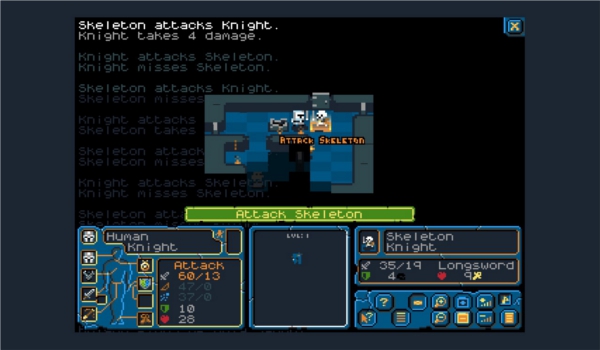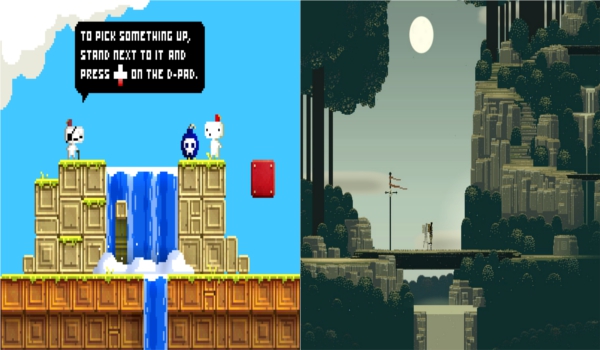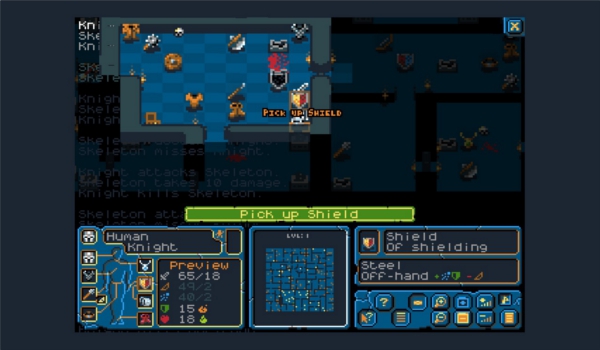Have you ever played an ATARI 5200? If so, you’re in for a healthy dose of nostalgia. If not, you’re in luck because Hack, Slash, Loot (HSL) will give you a vibe that it is paying homage to the 1980’s and you’ll get to visit the ghost of gaming’s past. This independently developed game radiates dated 80’s technology from the sound effects and visuals to the very theme itself.
HSL is first and foremost a ‘rogue-like’. Roguelike is a genre unto itself. Ever since the 1980’s with the release of the game (prepare to be stunned) Rogue, the term roguelike would be forever known to describe this style of gameplay. Roguelikes are usually indicative of a role-playing game characterized by levels that are randomized, turn-based movement and combat, and, of course, permanent death. By all means, HSL does not stray far from this mentality.
Stages are randomized and before you set-out you will choose a character and a story to throw that adventurer into. The differing stories are more along the lines of prologue text and don’t change the gameplay too much. Each different story may vary what monsters and obstacles lay in wait to exact your permanent death through turn-based combat. For example, one story will have a mage tower with magic glyphs on the floor that can either hurt or help you, or another story might have monsters that infect nearby peasants to transform them into demons. One of my favorite tales will have you desecrating tombs in search of some type of enchanted mask. Deciding which tombs to open feels a lot like gambling – when opening the stone lid you might find new equipment or a potion as a prize inside, but just like scratch-off lottery tickets, you lose more often than you win. More often than not a skeleton warrior will come to life from within a sarcophagus and it will always immediately attack first. So, knowing which character to bring to which story can help your survival substantially.

When choosing a character for a story it is a good idea to keep in mind that your first time entering a tale will more than likely kill you quickly. Your first time into a story is like testing the waters. You will enter a stage ignorant, die, and then try to pick an appropriate character for the job. As when adventuring into the catacomb to rummage tombs for the enchanted mask, it’s a good idea to bring a character that starts with high armor and a close-range weapon – like the knight. A knight is best because ninety percent of the enemies you fight in the catacombs will get to attack you first because they emerge from their tombs when you open them and removing a tomb lid takes your turn. A class that starts with high armor and a melee weapon is better suited than say a cloth-wearing mage that only fires projectile spells.
Besides figuring what character is best suited for each story you will also die due to trial and error. One example of this is when a giant scorpion is killed only to explode and poison you, which will undoubtedly spell inevitable death for you. So, finding a bow to dispatch a scorpion from a distance is necessary to lengthen your survival. Also, enemies are not completely stupid. They’re intelligent enough to let you take the next step forward when you’re both a space away from one another so they can get the first swing if you both have melee weapons drawn. In later levels hobgoblins might retreat at first sight of you to get reinforcements. All of these enemy abilities start to add-up and you will need to apply tactics and bottle-necks to survive inflated enemy numbers and tricks. Monsters and tactics do bring a variety to gameplay, it’s too bad though that the level design is bland and extremely repetitive.
HSL uses a very 80’s aesthetic for its level design and character animations, everything is very pixelated. The pixelization style is not done well and every level is uninspired from one stage to the next. Besides the way a map might be laid out, the only thing that is evident to distinguish one stage from the next are the doors changing colors. Every stage looks like the exact same dungeon with a checkered floor, torches, and stone walls. Pixelization does not necessitate a poor aesthetic experience as games like FEZ or Superbrothers: Sword and Sworcery have proven, but HSL’s visuals are completely unimaginative.

HSL suffers from a gaming aspect that most modern roguelikes do. This genre’s gaming model is based around very short play times, wherein you adventure and die in a relatively quick timeframe. When I am playing a roguelike on a PC or console I am at home. If I’m at home then I have other titles that have gaming models better suited for longer plays on a bigger screen. When I play a roguelike at home I think to myself “Why am I playing this and not something else more properly suited for at-home gaming?” Roguelikes feel as though their genre tropes are best fit for mobile gaming because of the short play intervals and the evanescent lifespan of your character.
Hack, Slash, Loot is a suiting name for this indie title even though it is not a hack’n slash Diablo clone. Rather, it is a turn-based ATARI-esque Rogue clone. A small number of aspects keep the game feeling fresh for a couple of hours. Some tactics must be applied to achieve victory and there is a small variety in monsters and what they do to keep your brain active. There are 32 unlockable characters to try and keep it fresh, but ultimately they do not change the game from one character to the next. And, there is plenty of loot to obtain which defines your character. The game follows the guidelines of what it takes to be a roguelike to the letter.

All of these features withstanding, HSL brings nothing new to the table and most won’t find anything here they haven’t seen a dozen times before, if not more. After thirty years of new and improved renditions of this genre, HSL is simply unoriginal, uninspired, and too repetitive. If you had a few hours to kill in a waiting room I might suggest it, but there is nothing unique in Hack, Slash, Loot to make it stand out for a recommendation. HSL is not bad by any stretch but it belongs in the middle of the spectrum, in mediocrity.